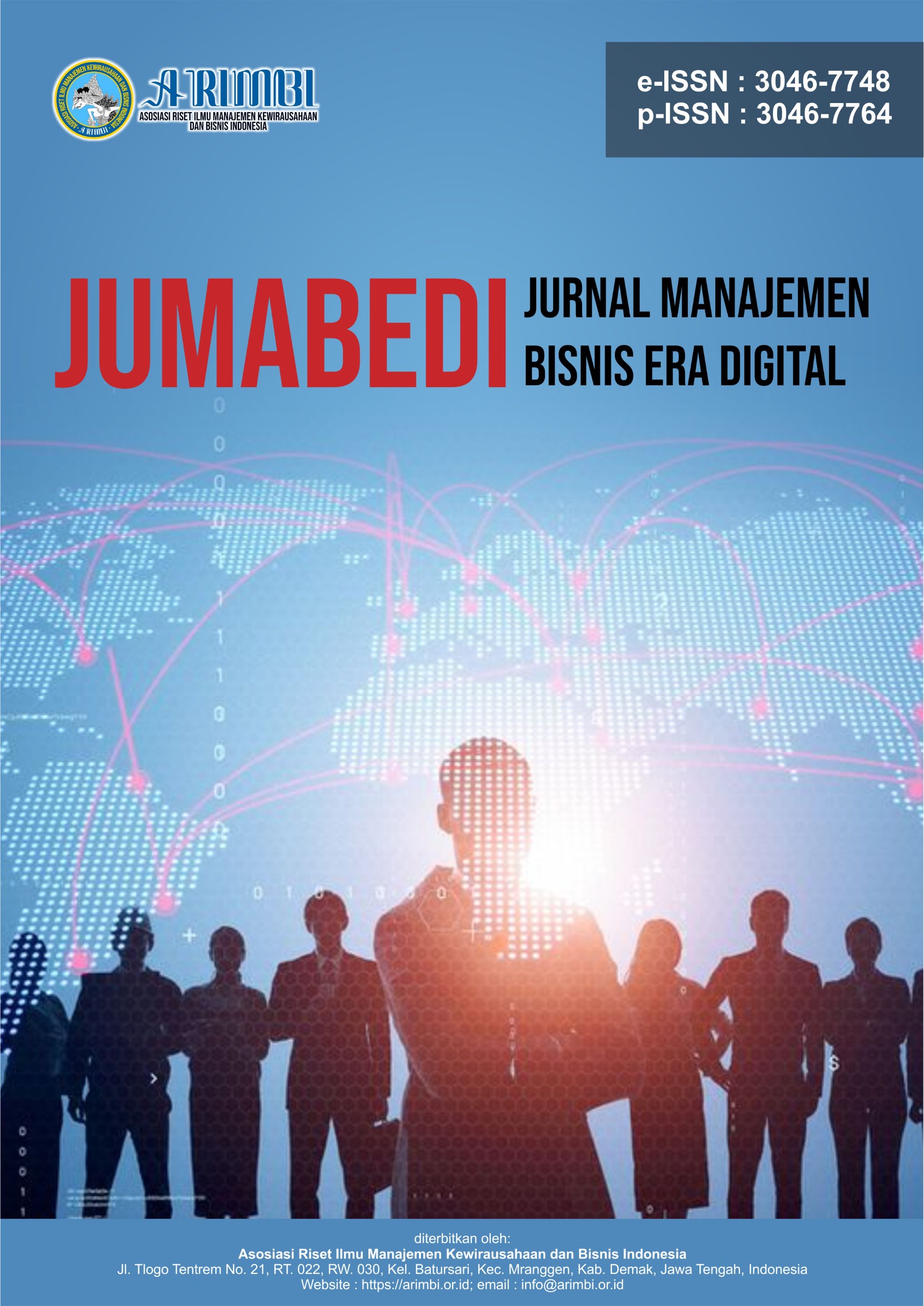Pengaruh Rasio Likuiditas, Solvabilitas, dan Aktivitas Terhadap Profitabilitas Pada Perusahaan Sub Sektor Otomotif Yang Terdaftar Di BEI Tahun 2020-2023
DOI:
https://doi.org/10.61132/jumabedi.v2i3.697Keywords:
Activity Ratio, Liquidity Ratio, Profitability Ratio, Solvency RatioAbstract
This study aims to examine the influence of financial performance ratios—namely, the liquidity ratio (Current Ratio/CR), solvency ratio (Debt to Asset Ratio/DAR), and activity ratio (Total Asset Turnover/TATO)—on the return on assets (ROA) of companies in the automotive sector listed on the Indonesia Stock Exchange (IDX) during the period 2020–2023. Employing a quantitative research approach with purposive sampling, the study focuses on automotive sector companies that met specific criteria over the observed time span. Data analysis was conducted using EViews version 13 software, and the methodology included descriptive statistics, panel data estimation, classical assumption tests, panel data regression analysis, t-tests (for partial effects), F-tests (for simultaneous effects), and coefficient of determination (R²) tests. The partial test results reveal that the liquidity ratio (CR) has a negative but statistically insignificant effect on ROA, indicating that higher liquidity does not necessarily enhance profitability. Similarly, the solvency ratio (DAR) demonstrates a negative and insignificant effect on ROA, suggesting that increased debt levels are not significantly associated with lower returns. In contrast, the activity ratio (TATO) has a positive and significant effect on ROA, implying that better asset utilization contributes positively to profitability. When tested simultaneously, the combination of CR, DAR, and TATO shows a positive and significant influence on ROA, indicating that these financial ratios collectively impact the profitability of automotive companies. These findings contribute to a deeper understanding of how internal financial indicators relate to profitability in the automotive sector and can inform management decisions and investor evaluations.
Downloads
References
Argoputro, S. B., Agustiani, S., & Purba, J. H. V. (2023). Pengaruh likuiditas, solvabilitas dan aktivitas terhadap profitabilitas. Jurnal Ilmiah Manajemen Kesatuan, 11(2), 233–246. https://doi.org/10.37641/jimkes.v11i2.1778
Arie, H. M., & F. V. (2016). Pengaruh struktur modal, ukuran perusahaan dan profitabilitas terhadap nilai perusahaan otomotif yang terdaftar di Bursa Efek Indonesia periode 2011–2014. EMBA, 4(2), 485–497. https://doi.org/10.1016/j.ribaf.2023.101975
Basuki, A. T., & Prawoto, N. (2016). Analisis regresi dalam penelitian ekonomi dan bisnis (dilengkapi aplikasi SPSS dan Eviews). RajaGrafindo Persada.
Diana, A., & Tjiptono, F. (2022). Manajemen keuangan. ANDI Yogyakarta.
Fahmi, I. (2021). Manajemen kinerja: Teori dan aplikasi. Alfabeta.
Gatha, F. A., & Hernawan, E. (2022). Pengaruh likuiditas, solvabilitas dan aktivitas terhadap profitabilitas perusahaan subsektor makanan dan minuman yang terdaftar di Bursa Efek Indonesia (BEI) periode 2016–2020. Global Accounting: Jurnal Akuntansi, 1(3), 1–8.
Hanafi, M. M. (2016). Manajemen keuangan. BPFE-Yogyakarta.
Kasmir. (2015). Pengantar manajemen keuangan. Prenadamedia Group.
Kasmir. (2019). Analisis laporan keuangan (Edisi revisi, pp. 66–67). PT RajaGrafindo Persada.
Kusumaningtyas, E., Subagiyanto, Andinugroho, W. C., Jacob, J., Berry, Y., Nuraini, A., Sudjono, & Syah, S. (2022). Konsep dan praktik ekonometrika menggunakan Eview. Academia Publication.
Ratnasari, E., Herlambang, R. S., & Suprayoga, A. (2024). Pengaruh likuiditas dan solvabilitas terhadap profitabilitas pada perusahaan sub sektor otomotif yang terdaftar di BEI. Jurnal Minfo Polgan, 13(1), 647–656. https://doi.org/10.33395/jmp.v13i1.13771
Sugiyono. (2018). Metode penelitian kuantitatif, kualitatif, dan R&D (Sutopo, Ed.). Alfabeta.
Sujarweni, V. W. (2018). Metodologi penelitian bisnis dan ekonomi pendekatan kuantitatif. Pustaka Baru Press.
Wahyudi, S. T. (2020). Konsep dan penerapan ekonometrika menggunakan E-Views (Cet. ke-1). PT RajaGrafindo Persada.
Widarjono, A. (2018). Ekonometrika: Pengantar dan aplikasinya disertai panduan Eviews (Ed. ke-5). UPP STIM YKPN.
Downloads
Published
Issue
Section
License
Copyright (c) 2025 Jurnal Manajemen Bisnis Era Digital

This work is licensed under a Creative Commons Attribution-ShareAlike 4.0 International License.





